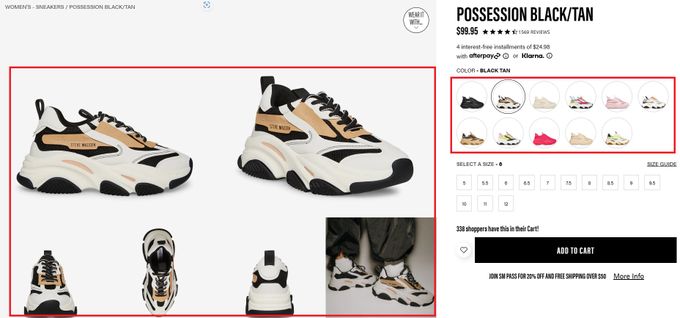eCommerce Visual Merchandising Guide: Improving the Online Shopping Experience
Updated December 12, 2025

Visual merchandising is an essential aspect of eCommerce that can significantly impact customer experience and sales. As a merchandiser, you have many tools to create an engaging and visually stunning eCommerce experience for your customers.
From designing navigation and product categories to using images and videos, every element of your online store can be strategically arranged to captivate and convert your customers.
What Is Visual Merchandising?
Visual merchandising is the process of designing and arranging the physical or digital presentation of products in a way that engages and entices customers. In eCommerce, visual merchandising refers to using online visual elements to create an appealing and intuitive shopping experience.
Your website's design, layout, and product displays are the first things your customers see, and they can significantly impact their purchasing decisions. An effective visual merchandising strategy for eCommerce can help your business stand out from competitors, improve customer engagement, and ultimately drive sales.
Pela: Sustainable Visual Merchandising Practices
For example, by using high-quality product images, you can give your customers a clear idea of the product they're interested in, thereby increasing the likelihood of converting and purchasing. Plus, if you couple this with effective calls to action, such as prominent "Shop Phone Cases" or "Shop Watch Straps" buttons, it can also help guide customers toward the right category.
A Look at Visual Merchandising in Traditional and Online Retail
The goals of eCommerce vs. retail merchandising are the same:
- Drawing in customers
- Building brand awareness
- Encouraging repeat purchases
- Streamlining the shopping experience
However, your visual merchandising strategy will vary depending on whether you're working in a brick-and-mortar store or an online marketplace. The key features, benefits, and drawbacks of each strategy are as follows:
Retail Visual Merchandising
Retail visual merchandising refers to curating product displays and layouts within physical stores to entice and captivate customers.
Pros
- Immersive shopping experience with physical interaction
- Efficient product placement & optimized store layout
- Instantaneous feedback for quick adjustments
- Opportunity for in-person engagement & personalized assistance
Cons
- Limited reach due to physical location
- Space limitations affecting display options
- Time-consuming updates with static displays
eCommerce Visual Merchandising
eCommerce visual merchandising involves presenting products and arranging displays within online stores to maximize customer engagement.
Pros
- Personalization based on customer behavior and preferences
- Flexibility with dynamic updates to adapt to trends
- Wider reach, accessible to a global audience
- Enhanced data insights for data-driven decision-making
Cons
- Lack of physical interaction with products
- Technical challenges in managing an eCommerce platform
- Security and privacy concerns with customer data
» Delve deeper into the similarities and differences between retail vs. eCommerce visual merchandising
Creating a Visual Merchandising Plan
Creating a cohesive and consistent visual identity is crucial for your eCommerce store. By ensuring that your website's visual elements, including colors, typography, and imagery, align with your brand values and target audience, you can establish a memorable and trustworthy image for your business. This, in turn, creates an immersive shopping experience that captivates your customers and drives results.
Popular Visual Merchandising Elements
Some examples of visual features that you can use to create an effective visual merchandising plan are as follows:
- Product images and photography
- Videos and animations
- Color schemes and typography
- Graphics, icons, and illustrations
- Product displays and arrangements
- Navigation and category design
- Calls-to-action (CTAs)
- Social proof elements
» Here's how to optimize your eCommerce merchandising management
The Benefits of Visual Merchandising
1. Increased Customer Engagement
By creating an immersive and interactive experience, you can hold the attention of your customers for longer. Whether this is through videos and animations showcasing your products in action or giving your customers more options than they bargained for, the right visual merchandising strategy will keep your customers engaged.
For example, popular designer Steve Madden gives their customers a view of their products from all sides. Each image is clickable and can be viewed in a larger format. Even the color variations of the particular shoe design are merchandised and easy to navigate. Because these merchandising elements help make the website easy to use, customers are encouraged to engage more.
2. Higher Conversion Rates
Visual merchandising, coupled with the right prompts, can help you increase your conversion rates and sales. Effective calls-to-action can encourage your shoppers to take action and complete their purchase, while showcasing related or complementary products can encourage customers to make additional purchases.
Keeping with the Steve Madden example, if customers are unsure how to style their purchase, the "Wear It With" section provides suggestions with clearly merchandised items to create a complete outfit. This gives Steve Madden the perfect opportunity to upsell and cross-sell.
» Find out why product recommendations also require merchandising rules
3. Improved Brand Recognition
Visual merchandising can improve brand recognition by establishing a consistent and memorable visual identity. When you use consistent branding across different touchpoints, you can create a strong visual presence that helps customers recognize your brand and strengthens your position in the marketplace. Additionally, incorporating user-generated content, such as customer photos and videos, can also help build customer trust and authenticity.
For example, apart from social proof elements like product reviews and ratings, Steve Madden also encourages customer engagement on social media, where customers can share photos and stories of enjoying their purchases.
» Discover how user generated content influences brand loyalty
Boost Your Customer Satisfaction the Fast Way
Visual merchandising is a vital aspect of your eCommerce store that significantly impacts customer experience and sales. By strategically arranging every element of your online store, from navigation and product categories to images and videos, you can create an engaging and visually stunning shopping experience for your customers.
Implementing effective visual merchandising strategies such as high-quality product images, calls to action, consistent branding, and social proof elements can increase customer engagement and loyalty and ultimately lead to higher conversion rates.
Therefore, it's essential to have a cohesive visual merchandising plan aligned with your brand identity, target audience, and business goals to drive results and stand out from competitors.
» Explore this ultimate merchandising guide for more best practices








